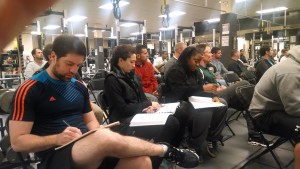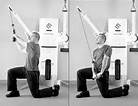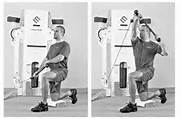Over the last three months our team has sought to open the communication with the community surrounding the strength and conditioning program at Cardinal Gibbons High School. It has been a great experience and well received by many people visiting the website, posting on twitter as well as engaging us on a new Instagram account @strength_cghs. We have blogged about continuing education, equipment, nutrition, exercise technique, and performance results.
In this last blog of the series I’d like to conclude with this important topic of planning for durability. This is how to build a more durable athletic body. My education and experience as a coach has showed me the body is only as strong as the weakest link. The first full-time college strength and conditioning coach Boyd Epley began with durability and therefore I appeal to our readers this is the most important. I wish someone would have shared these facts with me.
Fact #1: It takes time and effort to build a durable body to compete.
I sat with a colleague awhile back and we discussed the timeline needed to get an athlete fit, strong, and powerful. You can look at the scientific research and see training for these targets takes a considerable amount time. The development of these separate targets must be trained independently of each other and it takes multiple weeks to hit the target. It takes 6-8 weeks to get fit. It takes a minimum of 8 weeks to get strong and it takes at least 4 weeks to get powerful. This doesn’t even keep in account different timelines for the skill development process!
Fact #2: Sport competition calendars are expanding
We live in an era where there are club season, summer league, fall season, spring season, and the main season. Author Vladimir Issurin, who wrote the book Block Periodization in 2007, documents the expanding sport season which leaves smaller and smaller blocks for players’ skill development for long-term training development to increase durability for sport. In the 1980’s total days of competition ranged around 20-24 weeks. In the 1990’s this expanded to 30-32 weeks and has continued to grow (Issurin, 2007). At Cardinal Gibbons we strive to train twice a week year-round so it is possible for the young athlete get stronger and faster throughout their high school experience.
Programming for longer periods of time including meso-cycles and macro-cycles while hitting specific training targets has led to greater durability of athletes at Cardinal Gibbons High School. Basic exercise movement patterns have taken 3 to 6 months to master while increasing skill acquisition.
 Picture 1: Coaching Clinic at Wake Forest
Picture 1: Coaching Clinic at Wake Forest
Fact #3: The amount of overuse injuries and burnout have reached an all-time high
In January 2014 the Academy Clinical Sport Medicine (ACSM) published a position statement documenting the status of youth sports. Among the highlights of this statement it included:
There are many benefits to youth sports including self-esteem, socialization, and fitness
Many programs have an over emphasis on competitive success
Youth have begun high-intensity training at younger ages
Excessive focus on early compaction has focused on skill development rather than long-term training development
As strength conditioning coaches our objective is to develop raw athletic potential by balancing recovery modalities with strength training and sport skill development.
Fact #4: Including stability training creates durability
Many coaches have discussed the importance of creating a more stable foundation to build an athletic body. Gray Cook introduced the Functional Movement Screen and stated in his training video, “You can’t shoot a cannon out of a canoe.” Our coaching methodology seeks to develop athletes with basic ground based movements like the deadlift, squat, reverse lunge, and push-up.
Special consideration should be taken for young athletes and female athletes to produce programs that include neuromuscular proprioceptive movements like box drops and jumps. Overhead sports should include greater shoulder stability work.
One of the key movement patterns we are using more to increase durability is various chopping and lifting patterns with plates, balls, and bars to incorporate the “blocking” and “connecting” patterns of the opposite sides of the body that is prevalent in performing sport skills and movements. As time and technique allows, these developmental patterns should be used in our off-season, pre-season, and in-season routines to get soft tissue structure prepared for the high demands of sport.

 Picture 2: Chop and Lift movements can enhance core stability
Picture 2: Chop and Lift movements can enhance core stability
In conclusion, our goal in the future as cutting edge coaches is to advise athletes and coaches to plan long-term training so it can ultimately lead to a happier, more durable, and properly engaged athletes when the sports seasons do arrive. We have been successfully incorporating stability movements into the workout routine that has led to positive trends in creating more durable bodies.
This summer we will introduce a NEW topic series focusing on Coach Improvement so stay tuned. If you have a request on a certain topic please let our team know!
Chris Morland, MS, CSCS, SCCC, USAW
References:
Cook, Gray. Introduction to Functional Movements Screen Webinar, 2010.
Cook, Gray. Chops and Lifting patterns for athletes. PDF document from the certification process.
Defiori, John P. MD et al. Overuse Injuries and Burnout in Youth Sports: A position Statement from the American Medical Society for Sports Medicine Society for Sports Medicine. Volume 24, Number 1, January 2014.
Issurin, Vladimir, and Michael Yessis. “Breakthrough in Sports Training.” Block Periodization. Michigan: Ultimate Athlete Concepts, 2008. N. pag. Print.
